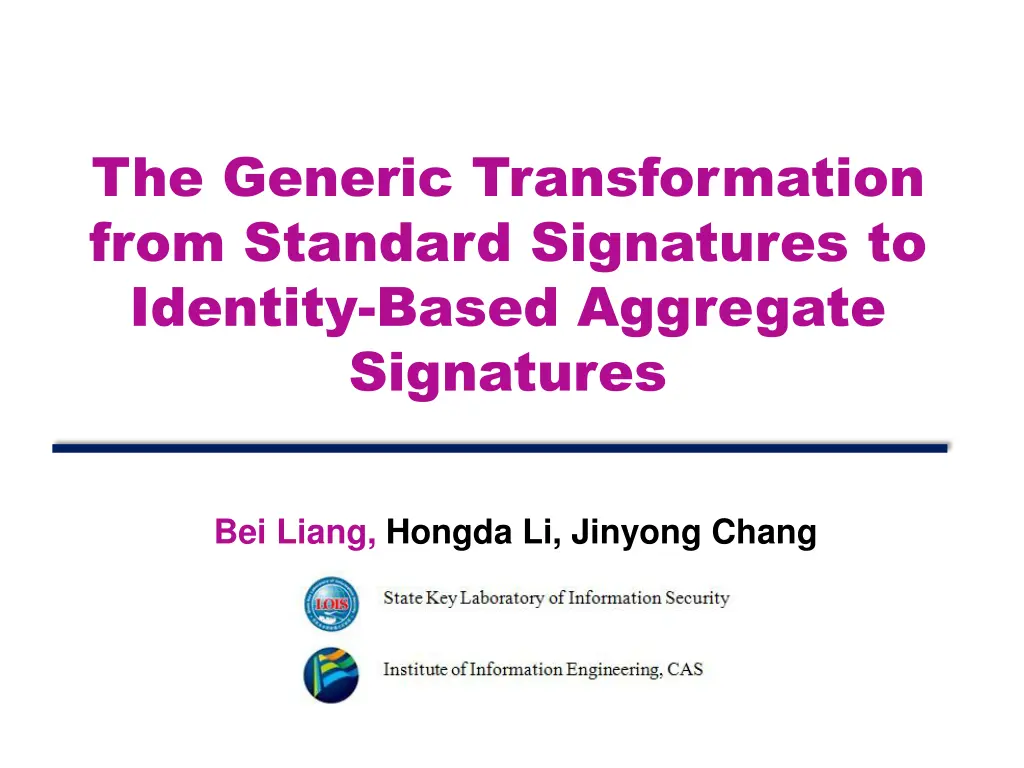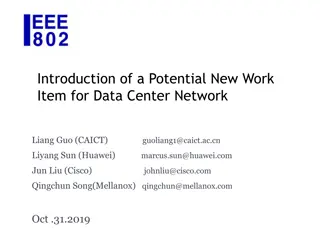
Transformation to Identity-Based Aggregate Signatures
Explore the transformation process from standard signatures to identity-based aggregate signatures in this comprehensive guide. Learn about the key concepts such as PK, MSK, signing messages, and authentication of signatories. Dive into the technical aspects and applications of Identity-Based Aggregate Signatures in modern cryptography.
Download Presentation

Please find below an Image/Link to download the presentation.
The content on the website is provided AS IS for your information and personal use only. It may not be sold, licensed, or shared on other websites without obtaining consent from the author. If you encounter any issues during the download, it is possible that the publisher has removed the file from their server.
You are allowed to download the files provided on this website for personal or commercial use, subject to the condition that they are used lawfully. All files are the property of their respective owners.
The content on the website is provided AS IS for your information and personal use only. It may not be sold, licensed, or shared on other websites without obtaining consent from the author.
E N D
Presentation Transcript
The Generic Transformation from Standard Signatures to Identity-Based Aggregate Signatures Bei Liang, Hongda Li, Jinyong Chang
Identity-Based Aggregate Signatures
Identity-Based Aggregate Signatures PK MSK
Identity-Based Aggregate Signatures PK MSK id1 id2 id3 Bob Eve Alice
Identity-Based Aggregate Signatures PK MSK id1SK1 id2 SK2 id3 SK3 Bob Eve Alice
Identity-Based Aggregate Signatures PK MSK id1SK1 id2 SK2 id3 SK3 Bob Eve Alice Sign m1 Sign m3 Sign m2 S1 S2 S3
Identity-Based Aggregate Signatures PK MSK id1SK1 id2 SK2 id3 SK3 Bob Eve Alice Sign m1 Sign m3 Sign m2 S1 S2 S3 Prove that Bob, Alice and Eve indeed sign the message m1, m2, m3respectively S1 S2 S3
Identity-Based Aggregate Signatures PK MSK id1SK1 id2 SK2 id3 SK3 Bob Eve Alice Sign m1 Sign m3 Sign m2 S1 S2 S3 Identity-Based Aggregate Signatures. Gentry and Ramzan. PKC 2006
Identity-Based Aggregate Signatures PK MSK id1SK1 id2 SK2 id3 SK3 Bob Eve Alice Sign m1 Sign m3 Sign m2 S1 S2 S3 Aggregator SA
Identity-Based Aggregate Signatures PK MSK id1SK1 id2 SK2 id3 SK3 Bob Eve Alice Sign m1 Sign m3 Sign m2 S1 S2 S3 Aggregator SA
Identity-Based Aggregate Signatures IBAS (with same common token) [BJ10] PKC 10 IBAS [GR06] PKC 06 Unrestricted IBAS. [HSW13] CRYPTO 13 Sequential IBAS. [BGN+06] CCS 07
Identity-Based Aggregate Signatures IBAS are restricted to: share a common token e.g., where a set of signatures can only be aggregated if they were created with the same common token require sequential additions e.g., where a group of signers sequentially form an aggregate by each adding their own signature to the aggregate-so-far
Identity-Based Aggregate Signatures How to achieve identity-based aggregate signatures from standard signatures?
Overview of our Approach Standard signature scheme Universal samplers [HJK+14] Identity-based signature Indistinguishability obfuscation [HKW14] Identity-based aggregate signature
Our Construction Standard signature scheme UP + iO + OWFs Identity-based aggregate signature* *: n-bounded IBAS, e.g. at most n signature can be aggregated.
Our Construction Standard signature scheme UP + iO + OWFs Identity-based aggregate signature* *: n-bounded IBAS, e.g. at most n signature can be aggregated.
Our Construction Standard signature scheme UP + iO + OWFs Identity-based aggregate signature* wCCA PKE Homomorphic encryption (puncturable) PRFs *: n-bounded IBAS, e.g. at most n signature can be aggregated.
Our Construction IBAS.Setup 1. HE.Setup 2. PKE.Setup 3. Creat program P0, iO(P1), iO(P2) ; 4. Output public parameters PP=(pkHE, U, P0, iO(P1), iO(P2)), master secret key msk=sk ; (pkHE, skHE), HE.Enc(pkHE,0) cti; (pk, sk), PRF key K, universal parameter U ; r=r0||r1 P0 1. SIG.Setup(r0) (vkSIG, skSIG), PKE.Enc(pk, skSIG; r1) c ; 2. Output (vkSIG, c);
Our Construction r=r0||r1 IBAS.KeyGen(sk,id) 1. InduceGen(U, P0||id) (vkid, cid); 2. Return PKE.Dec(sk, cid) skid; P0 1. SIG.Setup(r0) (vkSIG, skSIG), PKE.Enc(pk, skSIG; r1) c ; 2. Output (vkSIG, c);
Our Construction r=r0||r1 IBAS.KeyGen(sk,id) 1. InduceGen(U, P0||id) (vkid, cid); 2. Return PKE.Dec(sk, cid) skid; P0 1. SIG.Setup(r0) (vkSIG, skSIG), PKE.Enc(pk, skSIG; r1) c ; 2. Output (vkSIG, c); IBAS.Sign(skid,m) 1. SIG.Sign(skid, m) ; 2. Return ;
Our Construction IBAS.Aggregate(PP,{(idi,mi), i}i) 1. InduceGen(U, P0||idi) (vki, ci) ; 2. Return iO(P1)({vki,(idi,mi), i}i) ; {vki, (idi,mi), i}i P1 1. Compute t= 1 ct1+ + n ctn; 2. Compute si=F(K, vki||idi||mi||i||t) ; 3. Output agg=(t, isi);
Our Construction IBAS.Verify(PP,{(idi,mi)}i, agg=(t,s)) 1. InduceGen(U, P0||idi) (vki, ci) ; 2. Return iO(P2)({vki,(idi,mi)}i, agg); {vki, (idi,mi)}i, agg=(t,s) P2 1. Compute s = iF(K, vki||idi||mi||i||t) ; 2. Output 1 if s = s, else output 0 ;
Security Proof idea (id*, m*) (id*, m*) Game-0 P=(U, P P=(U, P0 0, , iO iO(P (P1 1), ), iO iO(P (P2 2)) )) id id (pkHE, skHE), (pk, sk), U, K, ct1=HE.Enc(0), ctn=HE.Enc(0), P0, iO(P1), iO(P2) sk skid id Attacker wins if: id*, m* not queried Verify({(id1, m1)}i, *agg)=1 id, m id, m (id (id1 1, m , m1 1), , (id*,m*), ,( ), , (id*,m*), ,(id idn n, , m mn n) ) * *agg agg
Security Proof idea (id (idi*, i*, m mi* i*) ) Game-1 P=(U, P P=(U, P0 0, , iO iO(P (P1 1), ), iO iO(P (P2 2)) )) id id (pkHE, skHE), (pk, sk), U, K, ct1=HE.Enc(0), ctn=HE.Enc(0), P0, iO(P1), iO(P2) sk skid id Attacker wins if: id*, m* not queried Verify({(id1, m1)}i, *agg)=1 id, m id, m (id (id1 1, m , m1 1), , (id ), , (idi*, i*, m mi* i*) ), , ,( ,(id idn n, , m mn n) ) * *agg agg
Security Proof idea (id (idi*, i*, m mi* i*) ) Game-2 P=(U, P P=(U, P0 0, , iO iO(P (P1 1), ), iO iO(P (P2 2)) )) id id (pkHE, skHE), (pk, sk), U, K, ct1=HE.Enc(0), cti*=HE.Enc(1), ctn=HE.Enc(0), P0, iO(P1), iO(P2) sk skid id Attacker wins if: id*, m* not queried Verify({(id1, m1)}i, *agg)=1 id, m id, m (id (id1 1, m , m1 1), , (id ), , (idi*, i*, m mi* i*) ), , ,( ,(id idn n, , m mn n) ) * *agg agg
Security Proof idea (vki*, ski*) SIG.Setup, ci* PKE.Enc(ski* ) (id (idi*, i*, m mi* i*) ) Game-3 P=(U, P P=(U, P0 0, , iO iO(P (P1 1), ), iO iO(P (P2 2)) )) id id (pkHE, skHE), (pk, sk), K, U=SimUGen(vki*,ci*) ct1=HE.Enc(0), cti*=HE.Enc(1), ctn=HE.Enc(0), P0, iO(P1), iO(P2) sk skid id Attacker wins if: id*, m* not queried Verify({(id1, m1)}i, *agg)=1 id, m id, m (id (id1 1, m , m1 1), , (id ), , (idi*, i*, m mi* i*) ), , ,( ,(id idn n, , m mn n) ) * *agg agg
Security Proof idea vki*, ci* PKE.Enc(1) (id (idi*, i*, m mi* i*) ) Game-4 P=(U, P P=(U, P0 0, , iO iO(P (P1 1), ), iO iO(P (P2 2)) )) id id (pkHE, skHE), (pk, sk), K, U=SimUGen(vki*,ci*) ct1=HE.Enc(0), cti*=HE.Enc(1), ctn=HE.Enc(0), P0, iO(P1), iO(P2) sk skid id Attacker wins if: id*, m* not queried Verify({(id1, m1)}i, *agg)=1 id, m id, m (id (id1 1, m , m1 1), , (id ), , (idi*, i*, m mi* i*) ), , ,( ,(id idn n, , m mn n) ) * *agg agg
Security Proof idea vki*, ci* PKE.Enc(1) (id (idi*, i*, m mi* i*) ) Game-5 P=(U, P P=(U, P0 0, , iO iO(P* (P*1 1), ), iO iO(P* (P*2 2)) )) (mi*, HE.Dec(skHE,t*)) Unforgeability of signature scheme id id (pkHE, skHE), (pk, sk), K, U=SimUGen(vki*,ci*) ct1=HE.Enc(0), cti*=HE.Enc(1), ctn=HE.Enc(0), P0, iO(P*1), iO(P*2) sk skid id Attacker wins if: id*, m* not queried Verify({(id1, m1)}i, *agg)=1 id, m id, m (id (id1 1, m , m1 1), , (id ), , (idi*, i*, m mi* i*) ), , ,( ,(id idn n, , m mn n) ) * *agg agg







